Vous souhaitez diviser de longues publications WordPress en plusieurs pages ?
Si vous êtes blogueur, le fait de diviser un long contenu en plusieurs pages permet à vos internautes de lire plus facilement les articles et de naviguer dans les différentes sections.
Dans cet article, nous allons vous afficher comment diviser les publications WordPress en plusieurs pages, étape par étape.
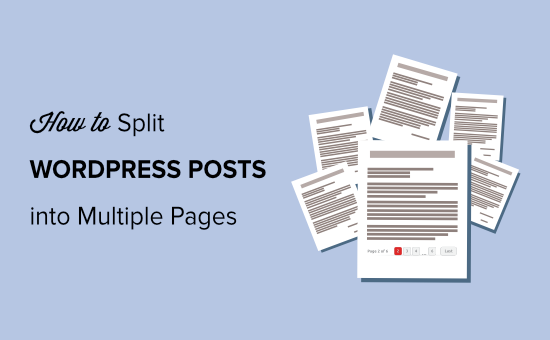
Pourquoi diviser les publications WordPress en plusieurs pages ?
Si vous avez des publications de blog ou des guides WordPress qui sont longs, alors le fait de configurer la pagination WordPress peut améliorer la lisibilité de votre contenu.
Il est utile de décomposer une longue publication en différentes sections et de les diviser en plusieurs pages. De cette façon, les internautes peuvent facilement digérer votre contenu et lire n’importe quelle section qui les intéresse.
Un autre avantage de la division des publications WordPress est qu’elle peut stimuler l’engagement de vos utilisateurs/utilisatrices. Lorsque les utilisateurs/utilisatrices naviguent dans un contenu paginé, chaque page qu’ils/elles voient contribue à augmenter le nombre de pages vues, ce qui peut avoir un impact positif sur les métriques globales de votre site.
Cela étant dit, voyons comment diviser les publications WordPress en plusieurs pages. Nous allons voir comment diviser vos publications WordPress en plusieurs pages sans extension et en utilisant une extension WordPress:
- Méthode 1. Diviser une publication WordPress en plusieurs pages sans extension
- Méthode 2. Diviser plusieurs publications WordPress en plusieurs pages à l’aide d’une extension
Méthode 1 : Diviser une publication unique en plusieurs pages sans extension
La façon la plus simple de configurer la pagination des articles est d’utiliser le bloc « Saut de page » dans votre éditeur/éditrices de contenu WordPress. Vous n’avez pas besoin d’une extension WordPress pour diviser vos articles en plusieurs pages.
Tout d’abord, vous devez modifier ou ajouter un nouvel article sur votre site WordPress à l’aide de l’éditeur de blocs Gutenberg.
Ensuite, cliquez sur le bouton » + » à l’endroit où vous souhaitez diviser votre contenu et ajoutez un bloc Saut de page.
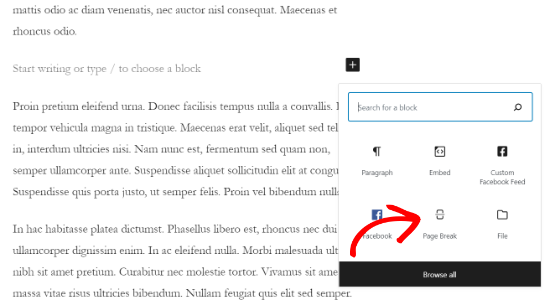
Vous devriez maintenant voir une ligne de saut de page dans votre contenu pour indiquer l’endroit où la pagination apparaîtra.
Il se présentera comme suit.
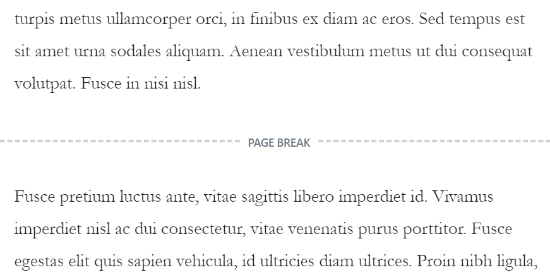
Si vous utilisez l’ancien éditeur classique, vous pouvez utiliser l’identifiant <!--nextpage--> pour diviser votre contenu.
Lors de la rédaction d’un article de blog, il suffit de se rendre dans la vue de l’éditeur/éditrice de texte pour saisir les identificateurs dans lesquels vous souhaitez diviser l’article long.
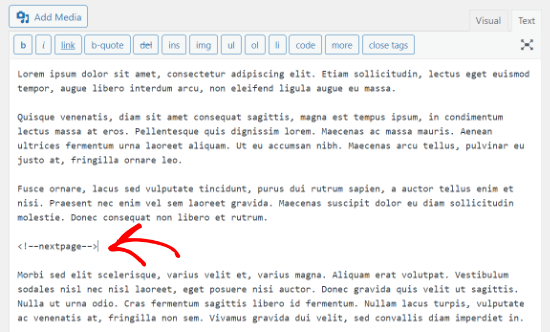
Vous pouvez également utiliser les touches Alt + Shift + P de votre clavier pour insérer des sauts de page. Pour ce faire, accédez à la vue « Visuel » et appuyez sur les touches de raccourci clavier à l’endroit où vous souhaitez ajouter un saut de page.
Ensuite, vous pouvez prévisualiser et publier la publication du blog. Vous verrez maintenant la pagination du post en bas du contenu de la publication.
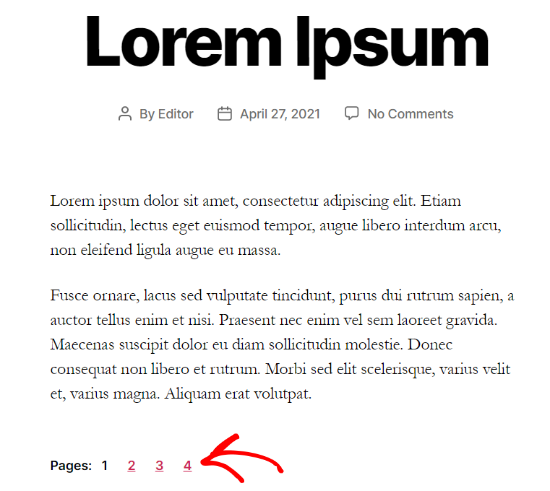
Méthode 2 : Diviser plusieurs publications WordPress en plusieurs pages à l’aide d’une extension
Une autre façon de diviser un long contenu en différentes pages est d’utiliser une extension de pagination. L’avantage de cette méthode est qu’elle pagine automatiquement les publications lorsqu’elles répondent à certains critères.
Pour cette méthode, nous utiliserons l’extension gratuite Automatically Paginate Posts, car elle est facile à utiliser et fonctionne avec n’importe quel thème WordPress.
Note : Vous remarquerez peut-être que cette extension n’a pas été testée avec les dernières versions de WordPress. Cependant, nous l’avons essayé nous-mêmes, et il fonctionne le mieux parmi toutes les extensions que nous avons vérifiées.
Vous pouvez en savoir plus sur la question de savoir si vous devriez utiliser des extensions WordPress non testées dans notre article. Si vous trouvez une extension qui fonctionne mieux que celle que nous avons proposée, alors n’hésitez pas à nous le faire savoir dans les commentaires ci-dessous !
Tout d’abord, vous devez installer et activer l’extension Automatically Paginate Posts sur votre site WordPress. Pour plus de détails, vous pouvez consulter notre tutoriel sur l ‘installation d’une extension WordPress.
Une fois l’extension activée sur votre site, allez dans Réglages » Lecture et défilez vers le bas jusqu’à la section ‘Automatically Paginate Posts’.
Vous pouvez sélectionner les types de publication à diviser en différentes pages. Choisissez ensuite de diviser les publications en fonction du nombre total de pages ou du nombre approximatif de mots par page.
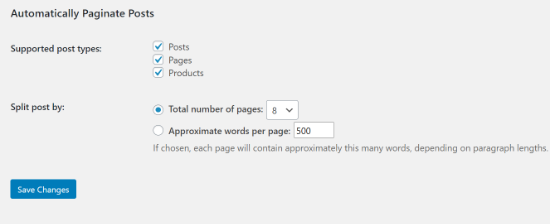
Cliquez ensuite sur le bouton « Enregistrer les modifications » pour stocker vos réglages.
L’extension définira automatiquement votre contenu en fonction de vos Réglages. Cependant, vous pouvez également ajouter des sauts de page manuellement à votre contenu tout en utilisant l’extension.
Astuce bonus : Utilisez AIOSEO pour optimiser la pagination de vos publications
La pagination de votre longue publication peut définitivement améliorer l’expérience des utilisateurs/utilisatrices. Cela dit, il est important que vous configuriez correctement la publication afin qu’elle n’ait pas d’incidence négative sur le SEO (optimisation pour les moteurs de recherche) de votre site.
Si une publication de blog est répartie sur plusieurs pages en raison de la pagination, Googlebot pourrait finir par indexer plusieurs copies du même contenu. Cela peut alors conduire à des problèmes de contenu dupliqué.
Heureusement, vous pouvez éviter cela en utilisant l’extension All in One SEO (AIOSEO). Cette extension de référencement WordPress permet de rendre votre site facile à référencer, même si vous n’avez aucune expertise technique.
AIOSEO insère automatiquement un numéro de page dans le titre SEO des contenus paginés. De cette façon, les moteurs de recherche peuvent comprendre que la publication a été répartie sur plusieurs pages et qu’elle n’est pas un duplicata d’une autre publication.
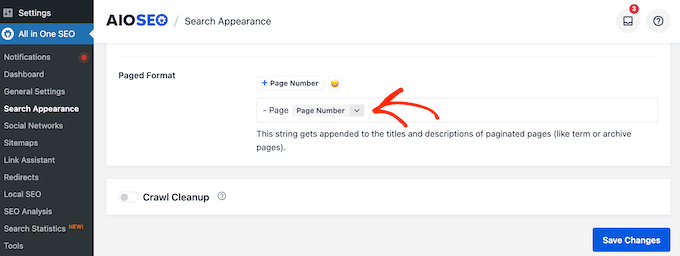
En outre, AIOSEO retirera ces numéros de page des URL de vos pages de publication. Les moteurs de recherche sauront ainsi quelle est la page principale de la publication du blog qu’ils devraient classer pour les mots-clés pertinents et que les utilisateurs/utilisatrices devraient voir en premier.
Pour ce faire, il active automatiquement le réglage « Aucune pagination pour les URL canoniques ».
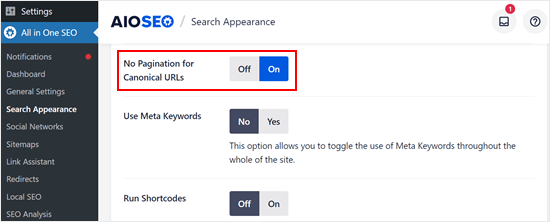
En savoir plus sur l’AIOSEO, veuillez consulter notre article sur la façon de configurer l’AIOSEO pour WordPress.
Nous espérons que cet article vous a aidé à apprendre comment diviser les publications WordPress en plusieurs pages. Vous pouvez également consulter nos choix d’experts pour les meilleurs constructeurs de pages WordPress et notre tutoriel sur la façon d’ajouter des notifications push web dans WordPress.
Si vous avez aimé cet article, veuillez alors vous abonner à notre chaîne YouTube pour obtenir des tutoriels vidéo sur WordPress. Vous pouvez également nous trouver sur Twitter et Facebook.





Syed Balkhi says
Hey WPBeginner readers,
Did you know you can win exciting prizes by commenting on WPBeginner?
Every month, our top blog commenters will win HUGE rewards, including premium WordPress plugin licenses and cash prizes.
You can get more details about the contest from here.
Start sharing your thoughts below to stand a chance to win!
maik says
How to invert the pagination, I want create a page and spliting in multiples pages to show the recent posts? : This mode: 3, 2, 1. and no Pages 1, 2, 3.
semmy says
Hi thank you very much for your tutorial. It’s work, oh ya I want to ask something about adsense, how we can add adsense below multiple pages, can you create a tutorial for that one? many thanks
Edwin says
Thanks for the tip, I’ve recently tried this, and the pagination shows up correctly, but when clicking the links (2,3,4,etc.), i get a page not found error. Do you have any idea what would cause that?
Ricardo Cury says
You might want to check you Permanent Links Structure.
Edmond says
Hi,
Can you please do a tutorial on how to create the « view all » function too, as it’s really very useful. I’ve seen a similar thing here: http://list25.com/25-most-expensive-private-jets-ever-made/ (http://list25.com/25-most-expensive-private-jets-ever-made/?view=all)
Thanks!
Edmond says
Hi,
Really love the feature of splitting pages. I also see that you have the « View All » option on list25.com. How can I add that same feature to my website? I’d really love to see a tutorial for this too.
João Paulo Porto says
i have the same question
João Paulo Porto says
If for some reason, pagination is not showing up after you have pasted the next page tags, then you would need to add the following code in your single.php loop.
Which code are you talking about? I really need this code.
Lester says
Olá João Paulo,
Have you noticed how to manage pagination on wordpress long posts? This thread is not really helpful. I´m using wp 2.2.2 and I´m looking for splitting long posts in 1,2,3,4…view all pages too !
WPBeginner Staff says
See how to add numeric pagination to WordPress themes.
Josh says
how to create pagination like wpbeginner.com ? thanks
Ameet Mehta says
Hi, where is the code that is supposed to be pasted, seems like something got pulled out of the article?
kankan929 says
YES!!!! I saw that Kim Komando did this and wondered HOW. So glad I stumbled across this blog. And now I’m a FAN! Thanks for sharing this information.
WPBeginner Staff says
Yes it does if you have long articles with lots of images. You split the page, which reduces the page load time. Increased page views and lower bounce rates are an added bonus.
MikeMeisner says
Great little tip – do you think this helps with SEO and rankings by lowering the bounce rate and increasing pageviews? I notice a few buzzfeed types sites using this method..
Donna says
what is a single.php loop? where do I place that code? the pagination is not working for me.
Jamie_Mannion says
I paste the code in the text view, switch to visual and it’s there as I pasted it, switch back to text and it shows as <!––nextpage––> the problem was the « pasting ». I manually typed it and I was away. Thanks guys!
Patrick says
Hi Syed,
Thanks for the tip. I’m wondering, though, the page numbers come up at the top of the post, rather than following it. How can I change that, or at least duplicate it?
Bonnie Martin says
Awesome tip. I didn’t know about that before this.
James says
Hi Syed,
I have just implemented a facebook like button at the top of every post page. and split a few long blog posts up into multiple pages.
The problem is if someone is on page 3 of the article for example, and clicks the share button, the url of that page gets shared – nameofsite.com/nameofpost/3.
How can I ensure that just the first page/main page of the post gets shared with all my paginated posts?
Thank you,
James
Boby Kurniawan says
You know , i always love this website. I found many wordpress trick here. Thank you .
I have a question, how i put the « split » at top of article after the title ? is it posible ? thanks .
Sorry for bad english
Basavaraj Tonagatti says
Hi,
I have few posts which have plenty of comments like around 800. Because of this these particular posts load slowly. So how if I paginate them by going to Discussion Settings–>Other Comments Settings–>Break Comments into pages of 100 each?
Lops says
Hey! This worked incredibly fine, replacing the — manually did fix it when it didn’t work and now it’s awesome.
I’m just having trouble because I’m working on very lenghty articles and I would like a table of contents at the top of the page too, not just at the bottom of the page. Can’t we have the [1] [2] [3] etc. links at the top of the page too?
ashutosh joshi says
I need to show « next page » and « previous page » in place of pagination. What should I do for that?
David says
Hi Syed,
Thanks for the tip. I have a question to be sure.
This will create duplicate content, as http://domain.com/postname, http://domain.com/postname/1/, http://domain.com/postname/2/.
Would it be correct to add, for example using the SEO Yoast plugin, the canonical url at http://domain.com/postname?
Would this reduce any problem for duplicate content in the major search engines?
Thank you.
WPBeginner Support says
WordPress SEO will make the actual post URL the canonical URL.
Administrateur
David says
You mean, without writing anything in the canonical url space? Does it do it automatically so that I don’t have to specify it?
Thanks
David says
Hi,
After a bit of investigation, I’ve found out that if you don’t write anything on WPSEO canonical space, wordpress will take care of it and create a different canonical url for each page, with duplicate content. It doesn’t play nice with all the themes probably, so it’s better to check.
So if you write the right canonical url (usually the main page) in the WPSEO space, it will index the first and not the others and will relate all the others pages /2, /3.. to the first. And this is one solution.
But if you want to index all the content of the other pages, because maybe they are worth it and long pages as well, then you can write « next » on the canonical space, and all the pages will be linked as rel= »next » and rel= »prev ».
Edward Chung says
Thanks for introducing the technique. What I concern most is the SEO implication, would the author please suggest whether the SEO would be hurt or not? Thanks!
WPBeginner Support says
No, if any thing it will probably improve SEO. Your page load time will increase, users will not have to scroll a lot this means user experience will improve. A Better user experience is also one of the factors considered by search engines when ranking a site. Using post pagination correctly will benefit your site’s SEO. However, using it just to increase page and ad impressions will probably backfire.
Administrateur
Oscar Gonzalez says
Do you know of a plugin or a hack that would allow me to give the user an option next to the pagination links when using multiple pages?
Like page 1, 2, 3,
OR below that show a link that reads:
view as one page
I think some big sites do that with slideshow posts, Any suggestions on providing that to the user?
Thanks!
Crear Cuenta Outlook says
thank for the info i will use this in my site, but how i can get pagination on the home page?
WPBeginner Support says
Here is how to add numeric pagination in your WordPress theme.
Administrateur
Crear Cuenta Outlook says
thanks
Kalyan says
I being having a travel blog (wordpress platform), thought of splitting the article. But, by using the method you said above, the url of the page is changing for each split. Is there any plugin or any thing which can split the article with the url remaining the same. Please let me know if you know any such plugin.
Thanking You
WPBeginner Support says
You can take a look at toggle effect to show/hide content in a post.
Administrateur
Diana says
The pagination shows up, but whenever I click to an actual page, it still shows me the entire article.
Laurence says
I leave blogs split over many pages they’re really annoying. I can’t scan the page so it takes too long. Especially the blogs that have. « Top 10 whatever » with each one on its own page. Just put them on one page for me why on earth make it harder for me to get content. I don’t think split pages decrease the average bounce rate across all pages.
Aslam says
I saw a lot of people complaining that the code tags aren’t working and the reason is that if you copy paste the on this page it will not work, maybe some character issue with the « — » characters on this page.
Just manually type the « — » wherever you are using the tag and it will work.
Manual typing worked for me.
Kristof Bernaert says
Exactly the problem I faced too. Thanks for posting that!
James Roland says
Thanks! That was my problem as well. Typing it manually did the trick
Aristides Guerra says
I almost gave up upon manually replacing the underscores ( _ ) from the code given above but then I also replaced the two dashes( — ) from
and it works! thank you all!
Seema says
Thanks Aslam, you solved my problem.
Tor André Sandum says
THANKS! Manually writing worked, copy/paste did not!
John says
@Syed Balkhi I have to agree with AleC that original post split looks very boring. Please write a detailed tutorial for a newbies like us, on how to give it a beautiful and stylish looks with eye catching colors, just like you are using at list25. Thanks and i hope you will share it soon with your regular reader. I will wait
WPBeginner Support says
We will try to show how to style WordPress post pagination links. Meanwhile, do check the Codex page for styling page links. Also feel free to study and use list25 stylesheet and modify it to match your theme.
Administrateur
Haseeb Ahmad Ayazi says
Whenever I google any wordpress query, wpbegginner come first, very hard @Syed Balkhi
Christina says
Thank you for your answer. That makes a lot of sense. One more question: Do you know a post pagination plugin with works in combination with a post index? I have some long posts on my website which have their own little post index. If I now implement a post pagination, I would like to keep the post index which means that if a user klicks on a post index element, he should then jump to a separate post sub page.
Christina says
Does post pagination have any impact on site performance/loading time? I was told not to implement it because it slows down the website. Is this true?
WPBeginner Support says
The purpose of adding pagination is to break down lengthy posts into pages. It should in fact speed up the page load time.
Administrateur
Lauren Wilson says
Is it possible to have two posts pages? i.e news and jobs?
Sri Ganesh.M says
Not Working, After which line in single.php we should add it ! i added in HTML view only
Kenshin says
Does this work on wordpress.com blogs also?
Editorial Staff says
Yes it should.
Administrateur
rami says
YUP!!!It Worked.Thanks for your great contribution.
Pranjal says
I thought, it wasn’t working on mine, lately I read it somewhere else, I need to put the given tag into html view, and finally it worked. Please mention in your article as well, as I know many noobs like me are out there
rami says
I agree with Pranjal. Please mention where the tag to be place.
Editorial Staff says
Updated the article.
Administrateur
Jose Robles says
Tried it but my links for the other pages shows up at the way bottom left of my website rather than appearing even before the comments. Any ideas why that would be? Website is ReignMediaLA.com and the theme is Press Grid.
Editorial Staff says
Sounds like an issue with your theme’s styling.
Administrateur
Eva says
Never mind.. Of course it worked AFTER I’d tried for half an hour and finally decided to complaint.
Of course it worked AFTER I’d tried for half an hour and finally decided to complaint.
Eva says
I’ve tried to use the code but all I get is the code text in my post :/ I’ve only used the HTML window to place the code and yet – there it is – on my post as text, not as next page.
What can I do?
AleC says
Hi guys,
Don’t ask me how, but I manage to do this in my site and it works like a charm!
BUT I don’t know how to give the numbers a style. I’m looking for something like you did in here, big numbers with a huge box of color. Can you help me with this? May be if you give me the line of code you used.
Sorry if I sound silly, but I don’t really know code.
Please!
Editorial Staff says
There is no code involved. You have to know CSS formatting.
Administrateur
Gidon says
Great! And so easy! Thank you!
Tom says
It wont work even if you follow these instructions, the correct code is ‘ not as you said (you had only single dashes) – also you should tell people that it needs to be entered in html view on visual.
Editorial Staff says
Ah darn the auto-formatting. It was showing correctly in the backend, but then on the front-end it turned our two dashes into one big dash. Fixed that. Thanks for pointing it out.
Administrateur
Colin says
Darnit, tried to get this to work on my site but failed
Was hoping as it was a premium theme it would work out of the box but sadly not.
As an SEO I can say there should be no problem with this SEO-wise. If anything having an extra couple of pages won’t hurt.
Raja says
Hi,
I tried what you’ve said, but ot still doesnt work on my theme. i’m using goodnews theme from themeforest
Editorial Staff says
Hey Raja,
This is a standard WordPress feature. If it doesn’t work with your theme, then you should contact the theme author and ask them to add the support for it.
Administrateur
wpbeginner says
You know Stephen, I would have agreed with you on almost all of those cases a few months ago. I still do agree with you that this works only in very specific cases. However, after seeing the numbers on our new site, my perspective has changed a little bit. First of all, if your article is good enough, then the user will go to the next page. In terms of SEO, definitely not true. If you have sufficient amount of content on each page, then it will not hurt you in SEO for a single bit. Forbes, NYTimes, and countless other big name sites do this and rank perfectly fine for SEO. If your content is good, then it will be shared, it will be linked, and it will be read by your users.
FuturePocket says
@wpbeginner I agree, I am planning to write a three part article (which is going to be somewhere in the area of 5000+ words) and I really don’t want to fit it all into one page. I am contemplating whether to stick with pagination or split it into multiple articles — but I will have to do a little bit more keyword research before I decide. If the ideas I intend to discuss are in a wide variety of keywords, than I’ll probably split it, otherwise this pagination method will work out quite nicely! Thanks for the share.
YuriyNikolaev says
Thanks God for give us WPBeginner!
Stephen Cronin says
Thanks for telling us how to do this, but I hope not too many people actually implement it and split their posts.
That’s a relic of the days when people artificially increased their page views to increase advertising revenue, but thankfully most people these days recognise that it leads to a poor user experience. I personally leave sites as soon as I see paged articles (unless I really *have* to read it).
There’s also the SEO implications – you’re probably going to rank better with one long article than you would with 5 smaller pages.
And I could go on, but I’ll stop there. It’s not a good idea in 99.9% of cases.